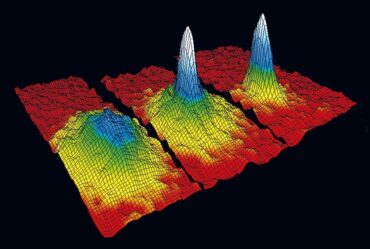
A new upper limit on the mass of neutrinos
Researchers with the KATRIN experiment determine that neutrinos are lighter than 0.8 eV/c2.
In a milestone that will bear on future discoveries in nuclear and particle physics, today an international team including scientists from MIT announced that they have established a new upper limit on the mass of the neutrino subatomic particle: 0.8 eV/c2.
Physicists say their understanding of the universe would remain incomplete without a detailed understanding the mass scale of neutrinos. Now, scientists with Karlsruhe Tritium Neutrino Experiment (KATRIN), located at Germany’s Karlsruhe Institute of Technology (KIT), have pushed our understanding of neutrinos’ mass with the new work, published in Nature Physics.
MIT has been a member of the KATRIN experiment since 2005. MIT researchers have helped construct the simulation framework used to understand the detector and developed tools used for the data analysis.
The team’s first reported measurement in 2019 yielded a result of 1.1 eV/c2. Scientists later broke the 1 eV/c2, a testament to the precision of the technique. Further measurement of the neutrino’s mass will continue through 2024.
To measure neutrino mass, KATRIN makes use of the beta decay of tritium, an unstable hydrogen isotope. The team was able to determine the mass of the neutrino via the measured energy of electrons released in the decay process. But to do so has necessitated a major technological effort: The experiment houses the world´s most intense tritium source as well as a giant spectrometer to measure the energy of decay electrons with unprecedented precision.
“The idea of using radioactive decays to measure neutrino masses is as old as the idea of the neutrino itself,” says Joseph Formaggio, lead principal investigator at MIT. “[Enrico] Fermi himself devised the technique back in the 1930s. But only now do we have the capabilities to make use of the technique to extract the neutrino mass with such precision.”
Scientists at the Tritium Laboratory Karlsruhe, which hosts KATRIN, has allowed safe handling of the chemical in quantities needed to reach experimental goals, the team said. KATRIN scientists have also worked to reduce background noise in the KATRIN spectrometer, another key factor in establishing the new upper limit for the mass of the neutrino.
“KATRIN is an experiment with the highest technological requirements and is now running like perfect clockwork,” Guido Drexlin, project leader at KIT and one of its co-spokespersons, said of the experiment.
Experimental data from the first year of measurements and then modeling based on a vanishingly small neutrino mass matched perfectly, the team reports. From this, a new upper limit on the neutrino mass of 0.8 eV/c2 was determined. It is the first time that a direct neutrino mass experiment has entered the sub-eV mass range, they say, where the fundamental mass scale of neutrinos is suspected to reside.
The KATRIN experiment will continue to take data over the next several years, eventually leading to a sensitivity of up to 4 times better that what we report today. “Hopefully a positve neutrino mass measurement is just around the corner,” says Formaggio, “It will truly round out our knowledge of the fundamental particles in our Standard Model.”
Formaggio is also working on a future experiment, called Project 8, that hopes to push the sensitivity to neutrino masses even further.
The KATRIN experiment is supported by funding agencies worldwide. Efforts in the United States are supported by U.S. Department of Energy (DOE) Office of Nuclear Physics.


